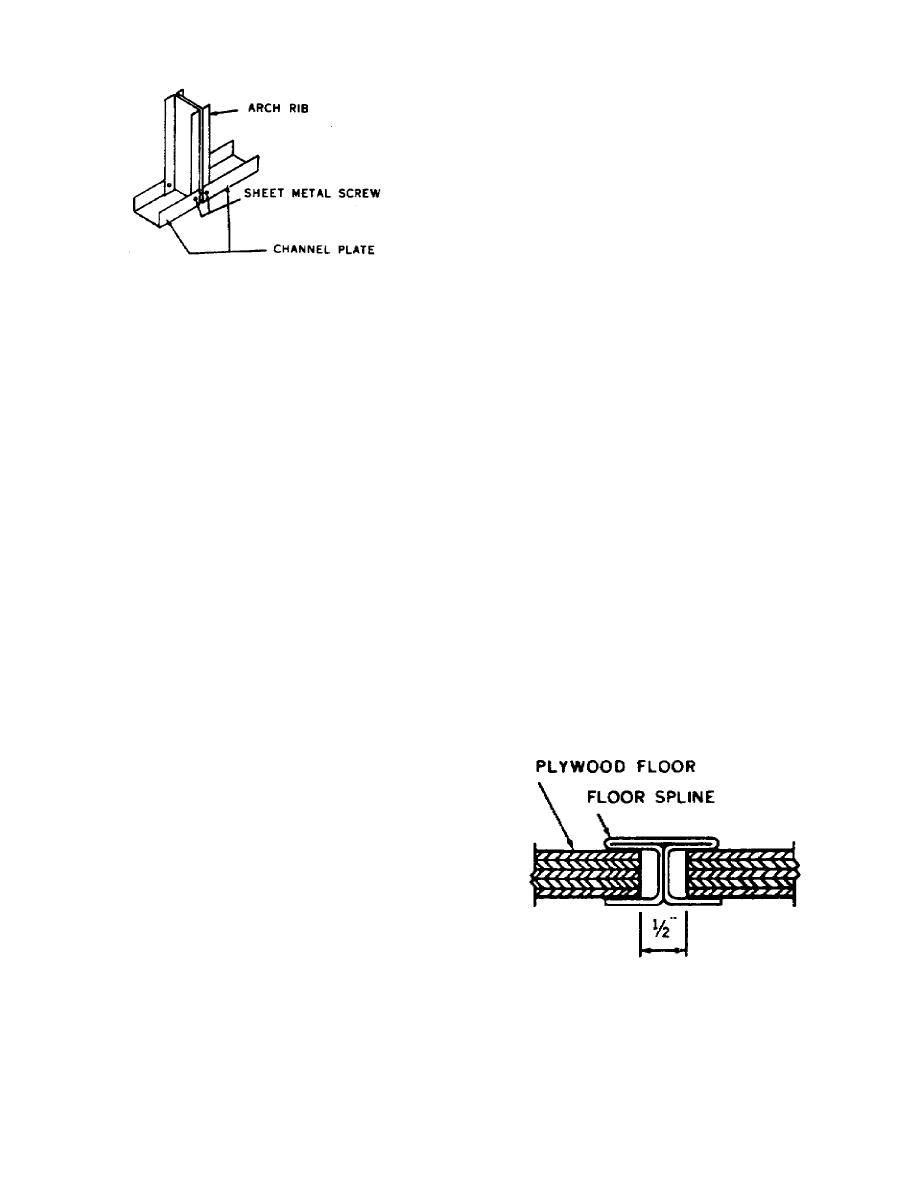
of channel plate. Alternate holes, inside right and outside
left or inside left and outside right, are normally used.
To remove a stud, you must gain access to both the
inside and outside screws. Figure 34 shows the location
of the framing members in an end section. The window
and door headers consist of channels that are fastened
between the studs. They serve as a fastening point for
siding, interior finish, and the window or door frame.
5-6. The sidewalls and roof are framed with arch
ribs, purlins, and window headers. The arch ribs are
spaced 4 feet on-center and extend from the channel to
the ridge or highest point in the building. Two arch ribs
are spliced at the peak with splice plates and bolts to
Figure 32. Joint and spline.
form a complete arch. The bottom of each arch rib is
fastened in the channel plate with sheet metal screws.
the top of the joists borders the floor and serves as a
Headers for the side windows are fastened between arch
fastening surface for the end wall studs and arch ribs.
ribs. Four purlins are fastened near the top of the arch,
Figure 32 shows the arch ribs connected to the channel
as shown in figure 34.
plate. This channel plate is comparable to the bottom
5-7. Corrugated sheet metal is used to cover the
plate used in a wood frame building.
arch. It is fastened horizontally on the side of the arch
5-4. The floor is made of 4x8-foot sheets of
to cover the area from the lowest purlin to the joist sill.
plywood. Twelve sheets of plywood are placed side by
The curved sheets that cover the top of the arch are
side on the joist along each sidewall to cover the length
placed across the purlins. Vents and roof jacks are built
of a 48-foot building. The two rows of sheets are butted
into the rounded sheets that are used on the purlins.
against the channel plates of the side walls. Six sheets of
These sheets are the same width and length as the others
plywood placed end to end fill the remaining 4 feet in
and are interchangeable with them so you can relocate
the center of the building. The actual floor width
the vents if necessary.
between the channel plates is 20 feet 1 inch, or 1 inch
5-8. Repairs to the exterior walls usually consist of
more than the 2 lengths and 1 width of the plywood
replacing the seals or retightening the fasteners around
sheets used as the floor covering. This 1-inch space is
the doors and windows. Figure 35 shows the shape of a
divided between the two center joints to allow a 1/2-inch
rubber seal that is used to prevent leaks at a joint made
crack between the ends of the side sheets and the edge
by corrugated metal and a flat surface.
of the center sheets. These joints are protected by the
5-9. When insulation is used in the walls of the
H-shaped metal floor splines, as shown in figure 33. This
quonset hut, it is fastened to wooden strips that are
spline protects the edge of the plywood, keeps the joint
placed between the arch ribs. The interior covering
clean, and allows for movement of the plywood sheets.
consists of plywood panels, 1/2-inch thick, that are easily
The wide joint and the slip-on spline make it easy for you
bent to fit the inside surface of the arch rib. An H-
to remove the center sheets, which are subjected to the
shaped spline is used along the sides of the plywood, and
most wear. Only 3 or 4 nails are used to fasten a sheet
a wood strip is used to cover horizontal joints. Figure
into place. Sixpenny common nails are driven through
the plywood and into the groove in the joist. Notice the
groove or separation along the top and bottom of the
joist shown in figure 31.
5-5. Walls. The end walls of the hut consist of
metal studs, channel plate, window and door headers, and
corrugated sheet metal siding. The studs set in the
channel are fastened into place with roundhead sheet
metal screws. One screw is placed through the inside
edge of the channel, and another is placed through the
outside edge of the channel. There are 4 screw holes in
the end of the stud, but it is not necessary to fasten
through each of them except to splice two lengths
Figure 33. Splicing channel plates.
19



 Previous Page
Previous Page
